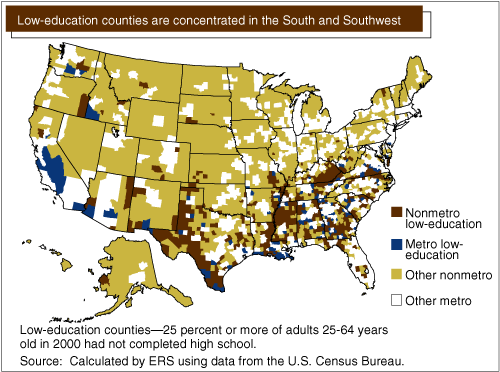Most Low Education Counties Are in the Nonmetro South
- by Robert Gibbs
- 6/1/2005
In today’s economy, workforce education is increasingly viewed as a potential catalyst for local economic and community development. Rural America now has twice the share of college graduates as a generation ago. Despite these overall gains, educational attainment varies widely within rural areas.
ERS’s recently revised county typology classifies low-education counties as those where at least one of every four adults age 25-64 has not completed high school. In 2000, ERS identified 622 low-education counties in the United States, with 499 (80 percent) in nonmetropolitan (nonmetro) areas. Nearly 9 of 10 low-education counties are located in the South, including a majority of southern counties with historically large shares of Blacks and Hispanics. Similarly, low-education counties in the West are concentrated in areas with large ethnic minority populations, such as California’s Central Valley and portions of Arizona and New Mexico.
More than half of all nonmetro low-education counties are persistently poor or have low rates of employment. In fact, the geographic concentration of rural low -education counties is similar to that of persistent poverty and low-employment counties, from Appalachia to the Mississippi Delta to the Rio Grande Valley. This geographic association reflects the difficulty that adults without high school diplomas have in finding and retaining jobs that pay enough to place them above the poverty line. It also underscores the difficulties faced by low-education counties in attracting good jobs and keeping highly educated residents.
Nearly half of the remaining nonmetro low-education counties—neither persistently poor nor low-employment—are dependent on manufacturing. Their relative prosperity is due largely to the presence of factory jobs that provide less-educated workers with stable work at family-sustaining wages. The long-term decline in manufacturing, however, may present a significant challenge to the future economic well-being of this group of low-education counties.
Population and employment in nonmetro low-education counties grew more slowly than the nonmetro average during the 1990s due in part to the reliance of these counties on older industries. The South, with a long history of low educational attainment, low-skill economies, and low rates of labor force participation, epitomized this trend. Low-education counties in the South had 13.5 percent employment growth in the 1990s, compared with the nonmetro average of 18.0 percent. Yet in the Midwest, the 27 nonmetro low-education counties outperformed other counties in both employment and earnings-per-job growth. This more rapid growth was due largely to Hispanic and Asian workers with limited formal education. Such regional differences in the causes and consequences of low-education populations suggest that local context is crucial when planning economic development strategies with a human capital focus.
This article is drawn from:
- County Typology Codes. (n.d.). U.S. Department of Agriculture, Economic Research Service.
- Employment & Education. (n.d.). U.S. Department of Agriculture, Economic Research Service.


